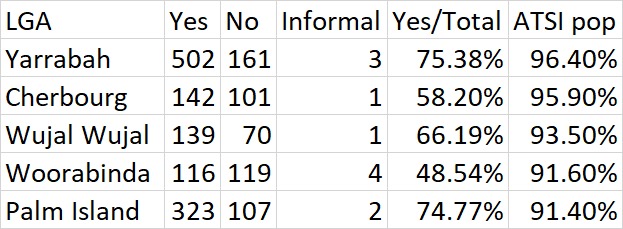Australia’s voice to parliament Polling catchments where Indigenous Australians form more than 50% of the population voted on average 63% in favour of the voice
Australia’s voice to parliament Polling catchments where Indigenous Australians form more than 50% of the population voted on average 63% in favour of the voice
Removed by mod
No that’s literally how statistical inference works. If you think they’ve made an error submit a letter and get them to retract the article.
Removed by mod
Sometimes assumptions have to be made especially in this case.
The AEC policy is to cast aside your vote so it doesn’t count towards the election - e.g. if you write your name or signature on the ballot paper, it will tossed out when they count the vote. If you take a selfie with your ballot paper showing how you voted, they are also required to discard your vote.
Reliable data on exactly how people voted is not available and cannot ever be available (under current laws)… so, yes, pretty much anything relating to the election is based on assumptions. That doesn’t make them useless. I’m assuming the sun will rise tomorrow morning… I don’t have any proof, but a lack of proof doesn’t make my assumption wrong.
The data they provided is pretty compelling - for example the Wadeye electorate where 92% of the vote was Yes. And by the way, about 90% of that electorate were are indigenous in the 2016 Census (pretty old now, but it likely hasn’t changed much).
What’s also interesting is those communities bucked other major trends in this election:
If indigenous and white people shared the same opinion on the vote, then you’d expect Wadeye to have one of the strongest No votes in the country. But nope - they voted 92% yes.
The person you’re arguing with understands this. They’re not asking in good faith.
Removed by mod
Ironic…
Removed by mod
Right back at you
Removed by mod
I think you’re misunderstanding the quote (or I’m misunderstanding you). That quote is supporting the same trend indicated in Wadeye. The 31.3% refers to QLD as a whole, not the ATSI dense communities specifically.
Removed by mod
I spent way too much time yesterday going through a full seat here in NSW comparing each polling location to the census data for that location, so I’m not going to do that all again for the entirety of QLD.
However, I did have a look at the QLD LGAs with the highest % ATSI populations and got the following results
I think that’ll be the closest sort of data we can get to an idea of the QLD ITAS support for the voice
Removed by mod
get them to retract it if you’re so sure.
Removed by mod